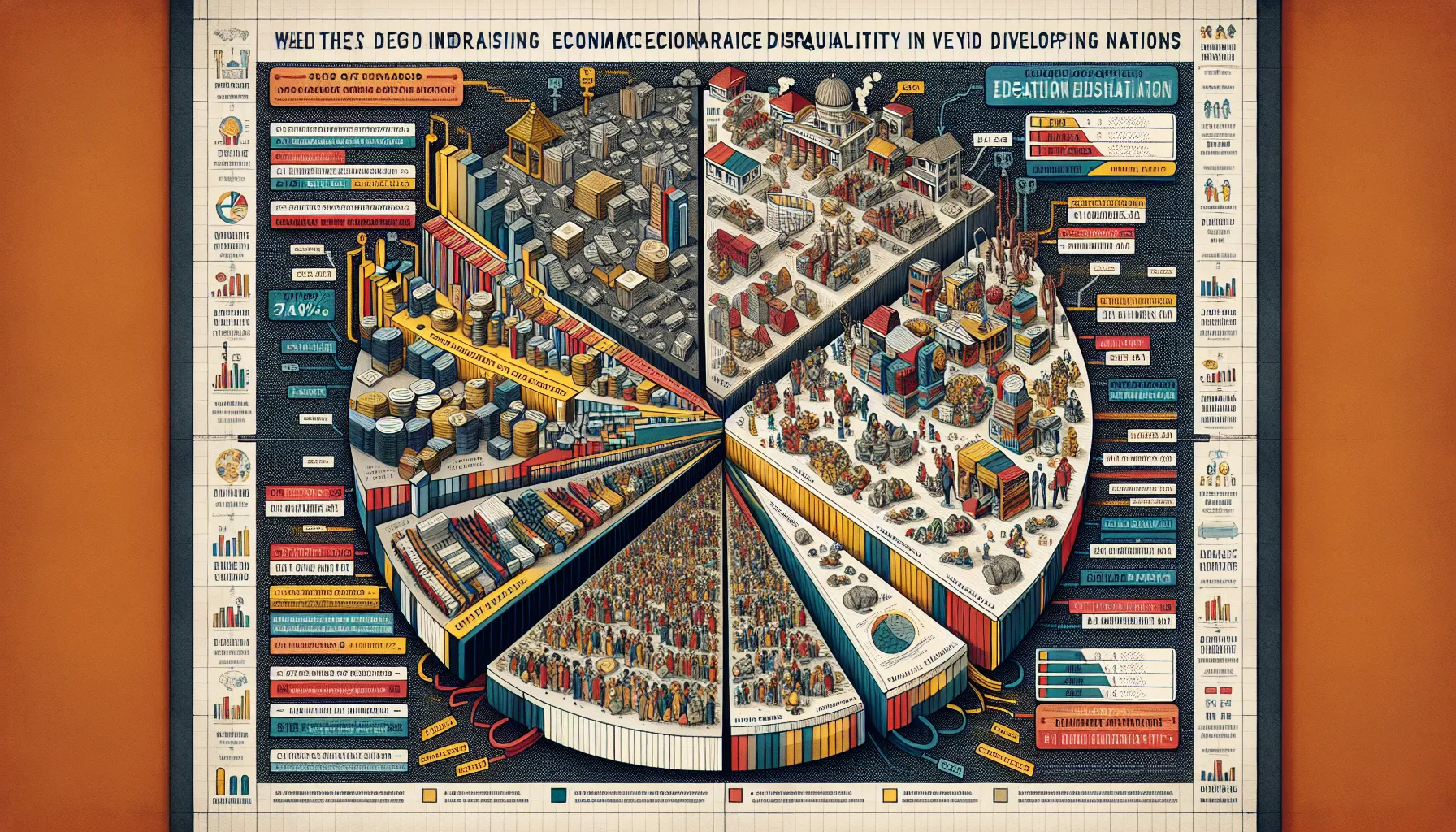Income inequality in developing nations is a crucial topic that frequently appears in IELTS Writing Task 2 exams. Based on recent trends and historical data from various IELTS preparation websites, this subject has a high probability of appearing in future tests. Let’s explore this topic through sample essays and in-depth analysis to help you prepare effectively for your IELTS Writing Task 2.
Analyzing the Task Question
Let’s consider the following IELTS Writing Task 2 question:
In many developing countries, the gap between the rich and the poor is increasing. What problems does this cause? What can be done to reduce this gap?
This question addresses the growing income inequality in developing nations and requires candidates to discuss its consequences and potential solutions. It’s a two-part question that demands a well-structured response covering both aspects.
Sample Essays for Different Band Scores
Band 8-9 Sample Essay
The widening disparity between the affluent and the impoverished in numerous developing nations is a pressing concern with far-reaching implications. This essay will explore the problems arising from this economic chasm and propose measures to mitigate it.
The increasing wealth gap in developing countries engenders several critical issues. Firstly, it exacerbates social tensions, potentially leading to political instability and civil unrest. When a significant portion of the population feels marginalized, they may resort to protests or even violence to voice their discontent. Secondly, this inequality hampers economic growth by limiting opportunities for the poor to invest in education or start businesses, thereby stunting overall national development. Moreover, it perpetuates a cycle of poverty, as children from low-income families struggle to access quality education and healthcare, diminishing their prospects for future success.
To address this growing divide, governments and societies must implement multifaceted strategies. One crucial approach is to reform tax systems, introducing more progressive taxation that ensures the wealthy contribute a fair share to national development. Additionally, investing in high-quality public education and healthcare can level the playing field, providing disadvantaged individuals with the tools to improve their economic standing. Governments should also focus on creating inclusive economic policies that promote job creation and entrepreneurship among lower-income groups. Furthermore, implementing social safety nets, such as conditional cash transfer programs, can provide immediate relief while incentivizing long-term investments in human capital.
In conclusion, the expanding wealth gap in developing nations poses significant social and economic challenges that require urgent attention. By adopting a combination of progressive taxation, investing in public services, and implementing inclusive economic policies, countries can work towards reducing this inequality and fostering more equitable societies.
(Word count: 278)
Band 6-7 Sample Essay
The gap between rich and poor in many developing countries is getting bigger, which causes several problems. This essay will discuss these issues and suggest some solutions to reduce the wealth gap.
One major problem caused by income inequality is social unrest. When people see a big difference between their lives and the lives of the rich, they may feel angry and frustrated. This can lead to protests and even violence in some cases. Another issue is that poor people have fewer chances to improve their lives. They might not be able to afford good education or healthcare, which makes it hard for them to get better jobs and earn more money.
To reduce this gap, governments can take several actions. First, they can change the tax system to make rich people pay more taxes. This money can then be used to help poor people through better public services. Second, investing in education is very important. If all children have access to good schools, they will have better chances in the future, no matter how rich or poor their families are. Lastly, creating more job opportunities, especially for people with lower incomes, can help reduce the wealth gap over time.
In conclusion, the increasing gap between rich and poor in developing countries causes social problems and limits opportunities for many people. By changing tax systems, improving education, and creating more jobs, governments can work to reduce this gap and create fairer societies.
(Word count: 235)
Band 5-6 Sample Essay
In many poor countries, rich people are getting richer and poor people are staying poor. This is a big problem that causes many issues. I will talk about these problems and some ways to fix them.
When rich people have a lot more money than poor people, it makes poor people angry. They might start protests because they think it’s not fair. Also, poor people can’t buy good things like education or medicine. This means their children might also stay poor when they grow up.
To make things better, the government can do some things. They can make rich people pay more money in taxes. This money can help poor people. Also, the government can build more schools so all children can learn, even if their parents don’t have much money. Another idea is to make more jobs for people who don’t earn much money.
In the end, having a big difference between rich and poor people is bad for a country. If the government tries to help poor people more, it can make the country better for everyone.
(Word count: 159)
 Income inequality in developing nations
Income inequality in developing nations
Analysis of Essay Structures and Band Scores
Band 8-9 Essay Analysis
This essay demonstrates excellent coherence and cohesion, with a clear structure and logical progression of ideas. The language used is sophisticated and precise, with a wide range of vocabulary and complex sentence structures. Key features include:
- Strong introduction that clearly outlines the essay’s focus
- Well-developed paragraphs with clear topic sentences and supporting details
- Effective use of linking words and phrases
- Relevant examples and explanations
- A concise conclusion that summarizes the main points
The essay addresses both parts of the question thoroughly, discussing problems and solutions in detail. It shows a nuanced understanding of the topic and presents a balanced argument.
Band 6-7 Essay Analysis
This essay shows good overall coherence and addresses the task adequately. The language used is generally clear, with some attempts at more complex structures. Key features include:
- Clear introduction that outlines the essay’s structure
- Paragraphs that address both problems and solutions
- Some use of linking words, though less sophisticated than the Band 8-9 essay
- Relevant ideas, though with less depth and fewer specific examples
- A conclusion that restates the main points
While the essay covers the required elements, it lacks the depth and sophistication of the higher band essay. The vocabulary range is more limited, and the ideas are less fully developed.
Band 5-6 Essay Analysis
This essay demonstrates basic coherence and attempts to address the task. The language used is simple and sometimes repetitive. Key features include:
- A basic introduction that states the topic
- Some attempt at paragraph organization
- Limited use of linking words
- Simple ideas that are relevant but not fully developed
- A basic conclusion that restates the main points
The essay covers the main requirements of the task but lacks depth and sophistication. The vocabulary is limited, and there are few complex sentence structures. The ideas presented are relevant but simplistic.
Key Vocabulary to Remember
- Income inequality (noun) /ˈɪnkʌm ɪnɪˈkwɒlɪti/ – The uneven distribution of income within a population
- Disparity (noun) /dɪˈspærɪti/ – A great difference
- Exacerbate (verb) /ɪɡˈzæsəbeɪt/ – To make a problem worse
- Marginalized (adjective) /ˈmɑːdʒɪnəlaɪzd/ – Treated as insignificant or peripheral
- Perpetuate (verb) /pəˈpetʃueɪt/ – To make something continue indefinitely
- Multifaceted (adjective) /ˌmʌltɪˈfæsɪtɪd/ – Having many different aspects or features
- Progressive taxation (noun) /prəˈɡresɪv tækˈseɪʃən/ – A tax system where the tax rate increases as the taxable amount increases
- Entrepreneurship (noun) /ˌɒntrəprəˈnɜːʃɪp/ – The activity of setting up businesses and taking on financial risks
- Social safety nets (noun) /ˈsəʊʃəl ˈseɪfti nets/ – Government programs that provide financial support to people in need
- Equitable (adjective) /ˈekwɪtəbl/ – Fair and impartial
Conclusion
Income inequality in developing nations is a complex and frequently discussed topic in IELTS Writing Task 2. By studying these sample essays and analyzing their structures, you can improve your ability to address such questions effectively. Remember to practice writing your own essays on this topic, considering various aspects such as economic policies, education, healthcare, and social welfare programs.
To further enhance your skills, try writing essays on related topics such as:
- The role of education in reducing income inequality
- The impact of globalization on wealth distribution in developing countries
- Government policies to promote economic growth while reducing inequality
Feel free to share your practice essays in the comments section below. This active engagement will help you refine your writing skills and prepare you for success in your IELTS Writing Task 2.


